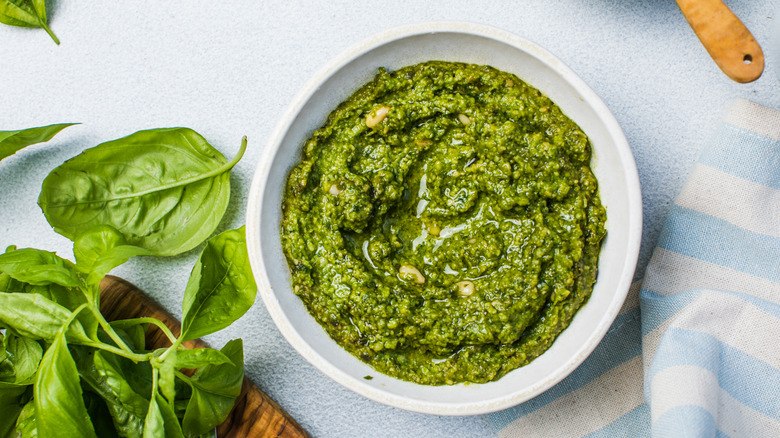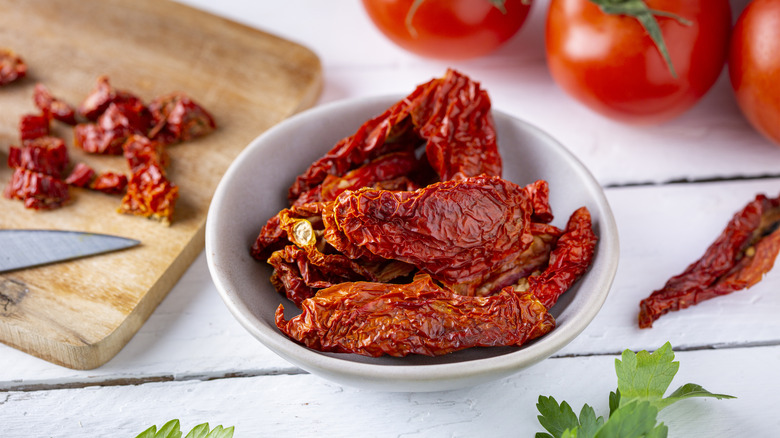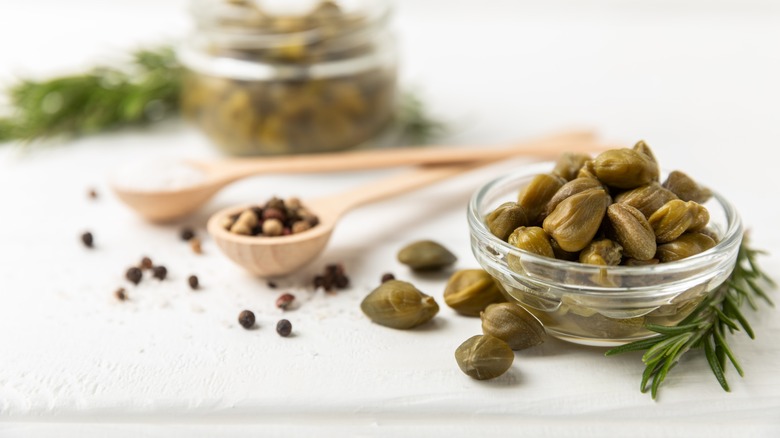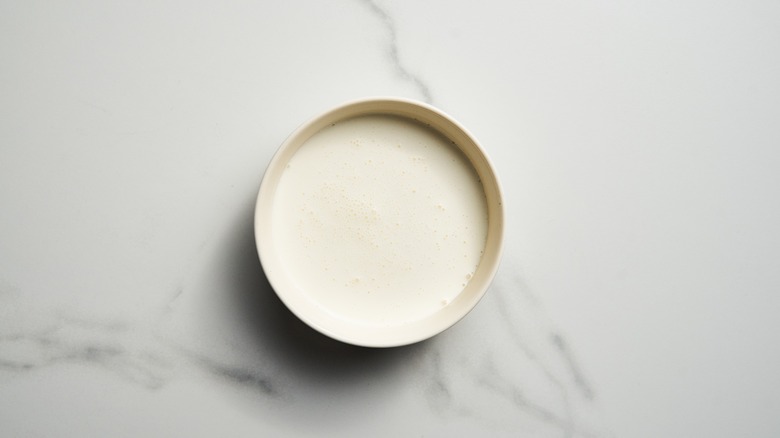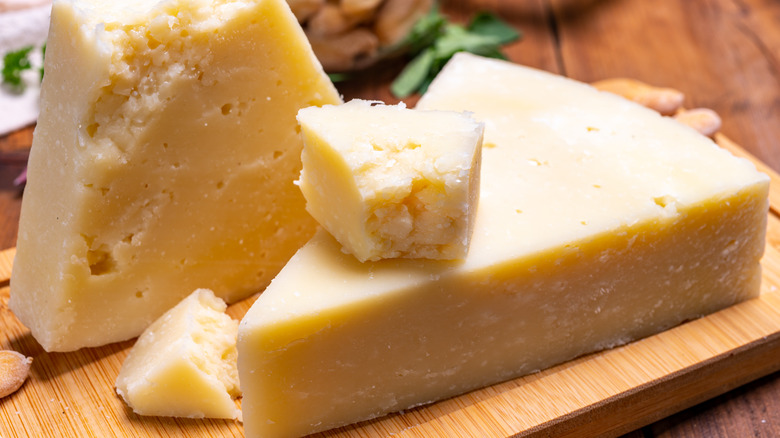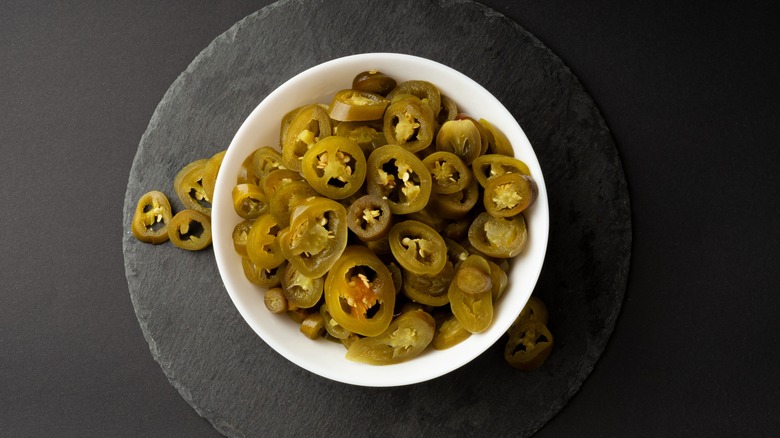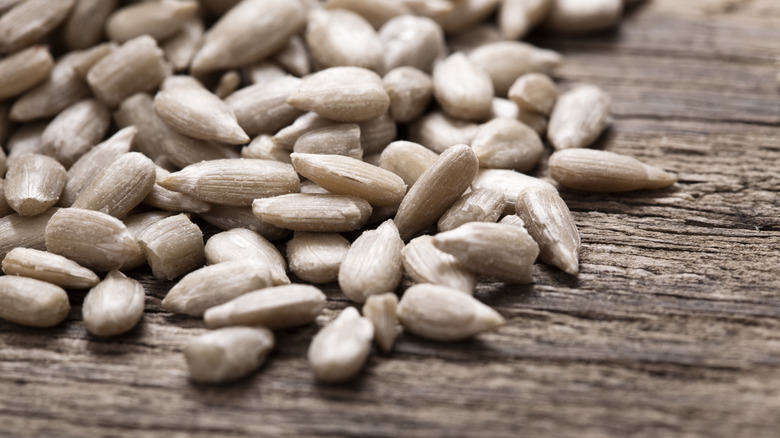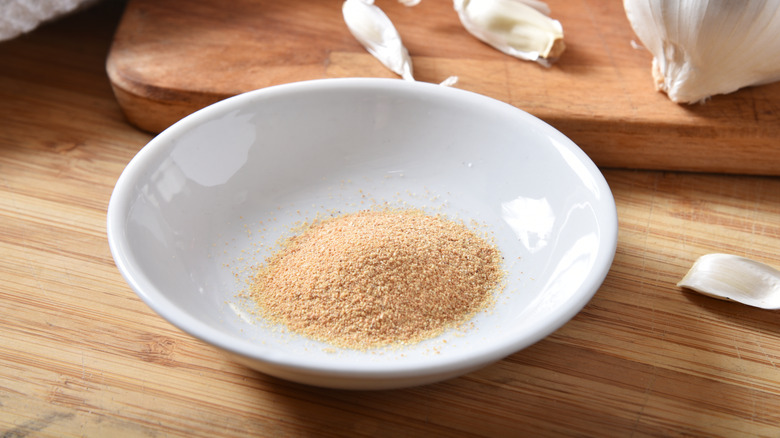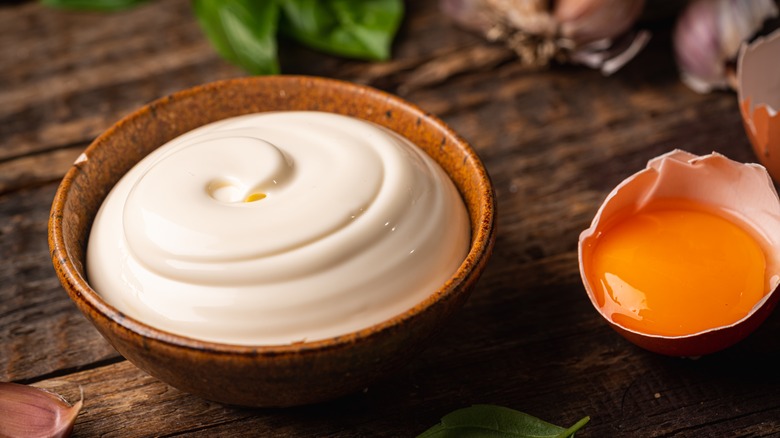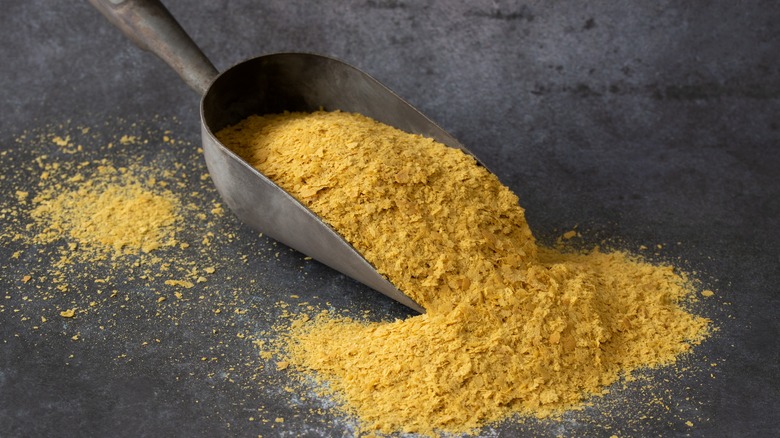12 Easy Ways To Elevate Store-Bought Pesto
Few sauces hit the spot like pesto. The timeless combination of basil, olive oil, pine nuts, garlic, and cheese goes with pretty much anything you choose, delivering a powerful punch of herbal, salty flavor wherever whatever you add it. Plus, while it may pay to make your own pesto, it's one of a few sauces that can be pretty good when store-bought. The more deluxe options out there can provide big flavor and that inimitable smooth-grainy texture. Unfortunately, however, that's not always the case — and if you find yourself with a store-bought pesto that's just not up to scratch, you may need to find a way to kick it up a notch.
Fortunately, that's pretty easy to do. Elevating store-bought pesto is a breeze, primarily due to the fact that this sauce is an uncooked amalgamation of several different ingredients. As such, it's super easy to stir in any number of things and for them to incorporate seamlessly with its savory, somewhat spiky flavor. Depending on what you need from your pesto, you can add smoothness, spiciness, a bigger hit of umami, or more acidity with some easy-to-find ingredients that you probably already have in the fridge.
1. Chop up some sun-dried tomatoes for additional umami
Sun-dried tomatoes are no stranger to pesto. These shriveled, chewy morsels can give pretty much any sauce a tangy flavor boost, and some pestos are based entirely around its flavor, which gives them an orange-red hue. The uniquely intense flavor profile of sun-dried tomatoes, with tartness coming from the natural acidity of the tomatoes and high levels of umami, can give pesto an extra forcefulness and zing, with the oil that they're usually packed in mellowing things out.
However, you don't have to make sun-dried tomatoes the primary flavor of your pesto. If you have a standard store-bought jar, simply chop up some sun-dried tomatoes and stir them in (before removing some of the pesto first — some of these jars can be full to the brim, making mixing in new ingredients tricky). The tomatoes will immediately start to imbue the pesto with flavor and will pair excellently with the herby basil notes. While you can use your pesto straight away, it's best to leave the newly-mixed sauce for a while, to allow the tomato flavor to incorporate properly. If you find it's too chunky after adding the tomatoes, smooth it out with some extra olive oil.
2. Grate in some dark chocolate
We expect a lot of things from pesto, but we generally don't expect sweetness. So when we first learned that you could spruce up your pesto with a small amount of chocolate, we've gotta say that we were pretty skeptical. Incredibly, however, it really works. The intensity of dark chocolate, in all its bassy, nutty, smoky glory, serves to fill in a key undertone in pesto that gives it an overall richer flavor. As dark chocolate is pretty bitter, you don't have to worry about it being overpowered with sweetness. Instead, you just get complexity and richness.
Dark chocolate is just as easy to add to store-bought pesto as it is to the fresh kind. You just have to grate a small amount into it, making sure you use the finest grater you can find, so that you don't end up with big chunks of chocolate throughout. Try not to go overboard here: A small amount makes a huge difference. We would also recommend using a dark chocolate with the highest amount of cocoa solids that you can find. The more cocoa there is, the more complexity you'll get, and the less sugar content it'll have.
3. Add some capers for extra zing
When pesto sits in a jar for weeks on end, it can lose a little bit of its sharpness. Fresh pesto has a bright, almost acidic note that pairs effortlessly with pasta, mozzarella, or tomatoes, but the store-bought kind can sometimes forgo this and end up a little dull. So, to brighten things up, add a few chopped capers. Capers have a deceptively complex flavor profile: They deliver acidity and saltiness from the brine, but also have an innately floral note and an undertone of umami that brings everything together. When added to pesto, they bring all of these traits to the party, with a mid-green hue that means they incorporate seamlessly.
Adding capers to store-bought pesto is super simple, too. Just fish a few out of the jar, chop them up, and pop them into the sauce, mixing them through and allowing them to sit for a while. You can use any type of caper you choose — and if you want to give your pesto a little more texture, mix some nonpareil capers in without slicing them at all. They're small enough to be added without preparation, and when you bite into them, they'll burst with a juicy acidity.
4. Swirl in some extra olive oil
Olive oil is a key component of pesto, whether it's store-bought or not. The fragrant oil brings all of your dry ingredients together, and slicks each tiny fleck of basil and morsel of pine nut with a smooth, fatty coating. It's the oil in pesto that gives it its luscious moreish taste, and which diffuses the sharper flavors into something way more mellow and rich.
With store-bought pesto, however, the oil can be in short supply. Jars of pesto can often be curiously dry, with the oil used pooling at the top and not incorporated properly – and cheaper brands can skip olive oil entirely, and go for a generic vegetable oil. So, to kick your store-bought pesto up a notch, glug in some olive oil. This will loosen up your pesto, making it easier for the sauce to coat your pasta strands, and give it extra flavor.
If you have the means, go for extra-virgin olive oil. The big difference between regular and extra-virgin is in its production method,which results in a different flavor. Extra-virgin has an intensity and a nuttiness that makes it perfect for using raw, like in your pesto.
5. Pour in heavy cream for added richness
If you haven't started using heavy cream in your pesto, you haven't lived. Heavy cream is one of the quickest and easiest ways to improve store-bought pesto, and turns it from a slightly grainy, loose sauce into a luxurious, smooth, thick, deeply-flavored liquid. Dairy is an essential component of pesto, thanks to the cheese in its standard recipes. By adding heavy cream, you're just kicking those smooth notes up a notch. The dairy fats that are swirled through the sauce give it an extra mellowness that's usually in fairly short supply, and makes it way easier for it to mix through noodles.
But why stop there? Using heavy cream in pesto opens up a whole new flavor world, and allows you to make a brand-new sauce with your store-bought variety. Try first sautéeing onions and garlic, and then swirling through your heavy cream-spiked pesto. These aromatics will give the pesto a deeper, vegetal, slightly more savory flavor, and pair well with the basil in the sauce. Sautéed mushrooms also go perfectly with a heavy cream and pesto combo, providing a woody umami flavor and a pleasing texture.
6. Add some shredded Romano cheese
Parmesan cheese is a key ingredient in classic basil pesto. The cheese adds a key umami note, deepening the sauce's flavor, and when it's heated up it helps it soften and spread smoothly through whatever you're mixing it into. In store-bought pesto, however, Parmesan can be in pretty short supply (usually because it's such an expensive ingredient, and manufacturers want to keep costs down), which is partly why some of them are so tasteless.
Instead of adding extra Parmesan, though, we would recommend swirling in some shredded Romano. There are a few key differences between Parmesan and Romano cheese, with the first and most obvious being their milk source. Parmesan comes from cow's milk, whereas Romano is a sheep milk-based cheese. This gives Romano a sharpness and slight aroma that Parmesan doesn't have, and when you add it to pesto it helps to round out its flavor and work as a counterpoint to the other cheese. Like Parmesan, Romano is a firm cheese, so it keeps its shape well when added to pesto — but because of this, you'll need to shred it finely, so that you don't end up with distracting chunks throughout your sauce.
7. A spritz of lemon juice will balance its flavor
There's something about store-bought pesto which can feel a little off. Sometimes, the recipes or production processes that manufacturers use can result in a sauce that feels overly salty or savory, and doesn't have any sense of equilibrium. One of the quickest ways to rebalance your sauce's flavor is by squeezing in some lemon juice. It's a quick fix, but it works: The acidity that lemon juice provides can highlight certain flavor notes that were previously sitting in the background. Simultaneously, it pushes against the richness of the olive oil and cheese and adds some brightness to the sauce that can get lost as it sits in the store.
Using lemon juice is also an easy way to thin out thicker pesto, which can bulk up once it's jarred. If you don't have any lemons, lime juice is a simple substitute, or you can add in a touch of white vinegar. Be careful with the latter, though: Adding even just a little too much vinegar can make your pesto briny and totally inedible. Add a drop or two at a time, mix it through, and then taste before adding more.
8. Stir in some jalapeños to boost its spice
Pesto has a hint of peppery spice from its basil, but the heat-heads amongst us won't be content with that. Nor should they be, when there are plenty of ways to add spice to pesto. Using chopped jalapeños is our favorite method. Jalapeños give pesto both a heat and a vinegariness from their brine, and their green color means that they don't distract from the uniformity of the sauce.
When adding chopped jalapeños, you'll want to make sure you mince them finely — the last thing you want is to bite into a huge chunk of pepper. Instead you'll want them to be well-incorporated. You should also taste-test the jalapeños you're using before you add them. If you add too many, you'll not only make your pesto too sharp and spicy, but you'll lose any subtlety of flavor in the sauce.
If you don't have any jalapeños to hand, never fear: You can still spice up your sauce. Chili flakes are an easy substitute, although we'd recommend that you allow them to sit in the pesto for a while to activate their heat. A pinch of cayenne pepper or chili powder can also give you the same effect.
9. Shake in some sunflower seeds for extra crunch
Pestos normally have a type of nut in them, with pine nuts being the most common in a classic pesto. However, when they're store-bought, they can lose their crunch. As the pesto sits, the morsels of nuts soften, turning from pleasingly crunchy to sort of gloopy and redundant. If you're missing that crisp factor, one of the quickest ways to add it back in without spending your evening grinding your own nuts is with sunflower seeds. These seeds are the ideal ingredient for a nut-free pesto, but you can use them in a nut-based one too. They're small enough to mix through it easily, and large enough to get your teeth around — and their nutty, woody taste helps deepen the sauce's flavor.
If you want something a bit more pronounced, pumpkin seeds can be a great alternative. As these are slightly larger than sunflower seeds, they'll give you slightly bigger chunks, but they're great if you want your pesto to have a little more texture. Toasted sesame seeds can also be a good choice, adding little pockets of crispness with a deep, round flavor profile.
10. Add some garlic salt for some mellowness
Classic pesto usually contains garlic, which gives the sauce a serious sharpness and a slight hint of spice. However, store-bought formulations tend to steer clear of adding too much, and it tends to be fairly low down on the list of ingredients. We can understand why — even just a little too much garlic can be totally overpowering — but we do miss the intensity that it brings to this sauce. Chopping your own garlic and adding it in, meanwhile, can be a bit of a risky game, and you may end up with a pesto that's seriously unbalanced.
That's why we love using garlic salt. A simple combination of salt and ground garlic, it adds a strong garlic note to anything it's mixed into without the acrid, sharp notes that the raw vegetable provides. As the name suggests, it also helps to season your pesto, giving it extra saltiness and flavor. If you think that your pesto is salty enough already, you can use ground garlic without any salt added. Whichever type you use, just make sure that you give it some time to sit before serving, to allow the garlic flavors to thread into the sauce.
11. Swirl in mayo for added body
Pesto isn't just meant for pasta. It's also one of the best sandwich spreads we have at our disposal, and can give any sammie a herbal punch and some much-needed zing. Have you tried to spread store-bought pesto on a sandwich recently, though? The moment it hits the bread, it seems to disappear, soaking into it and distributing across the sandwich poorly.
That's why you need to mix it with mayo. Making pesto mayo is a breeze, and requires just the two ingredients (plus a little extra salt if you want it to really pop). The mayo works to give your pesto way more body and make it more spreadable, while also giving it creamy, tangy flavor notes that pair seamlessly with its taste. Adding mayo to pesto also stops it from soaking into the bread so readily when added to a sandwich. That's not to say that you can only use this in your subs, though. Pesto mayo is the ideal dressing for a summer pasta or potato salad, and it can also be used to create a particularly herbaceous coleslaw.
12. Pour in some nutritional yeast for a cheesy note
Here's a pro tip: You don't have to add cheese to your pesto to make it cheesier. We know, kinda nuts, huh? When you have nutritional yeast to hand, you can get that cheesiness in mere seconds. There's a lot of confusion around what nutritional yeast actually is and how it gets its cheesy flavor, but it's essentially a dried fungus that's ground into a powder. It has an inherent cheesiness and a slight funkiness that makes it similar to Parmesan, which is partly why it's such a popular cheese substitute for vegans and those following plant-based diets.
It's worth bearing in mind, though, that nutritional yeast is quite fibrous, and as a result it can be pretty absorbent. If you're not careful, it can soak up the moisture in your pesto and give it a gloopy consistency. If you're adding it, make sure you add some extra olive oil to counteract any moisture absorption, or squeeze in some lemon juice to keep things nice and slack.
